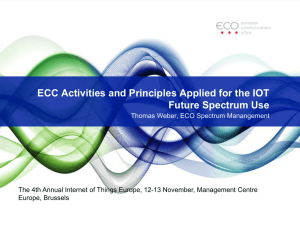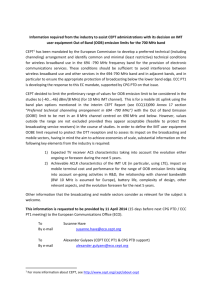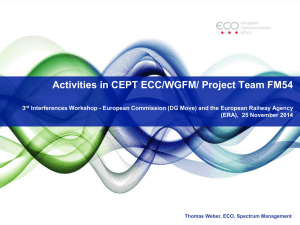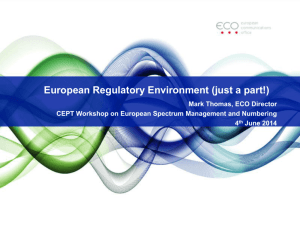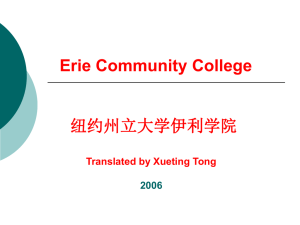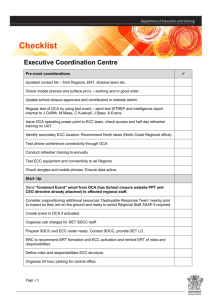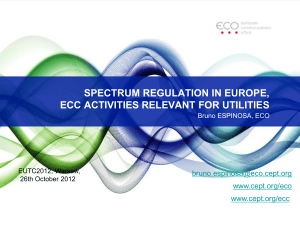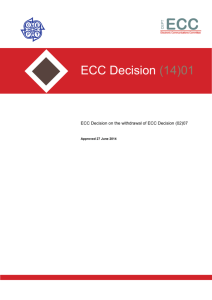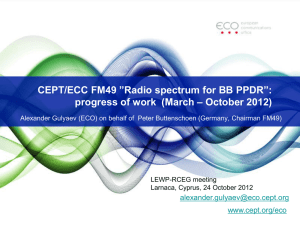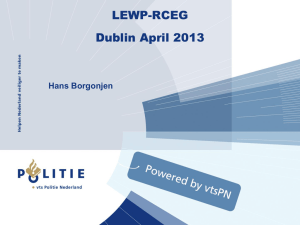Activities in CEPT ECC/WGFM in relation to the Evolution of the
advertisement
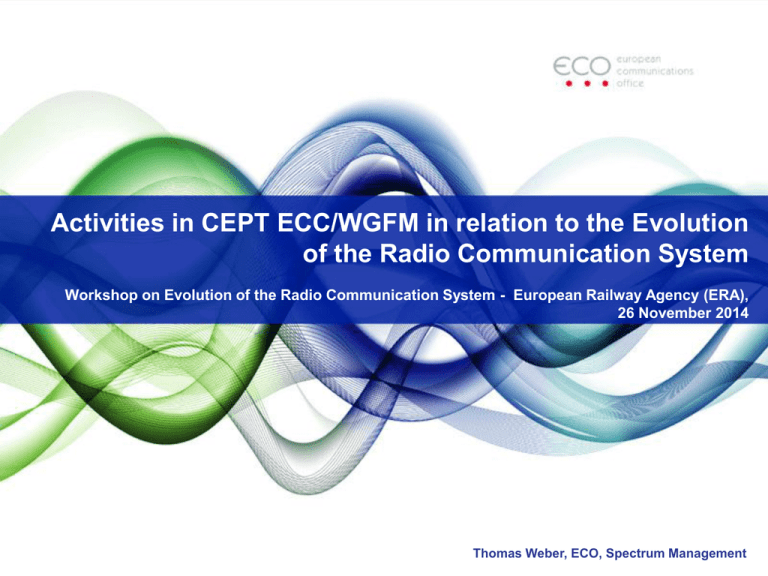
Activities in CEPT ECC/WGFM in relation to the Evolution of the Radio Communication System Workshop on Evolution of the Radio Communication System - European Railway Agency (ERA), 26 November 2014 Thomas Weber, ECO, Spectrum Management Content • Work and possible relation with regard to draft ECC Report 218 in ECC/WGFM Project Team FM49 on BB-PPDR • Roadmap BB-PPDR • Synergies, Principles, Process • Other Communications Where does the action take place? Relation to Draft ECC Report 218 • It is planned to submit the draft ECC Report to the next WGFM meeting in February 2015 for public consultation approval. This ECC Report is complementary to the ECC Report 199 “User requirements and spectrum needs for future European broadband PPDR systems (Wide Area Networks)”. • The process for this was triggered by ETSI SRDoc TR 102 628. The revised SRDoc also includes a section on synergies and mentions possible synergies between BB-PPDR, future railway communications and possibly other sectors such as ‘smart grids’. • Both, ETSI TR 102 628 and ECC Report 199 identifying 2x10 MHz as demand for BBPPDR wide area networks. • The RSPG Report on Sectorial Needs emphasises that the normal ETSI-ECC collaboration process should be followed to express spectrum needs (means ..SRDoc!). Note that there was also ETSI SRDoc TR 102 627 for E-GSM-R or ETSI TR 103 113 for Urban Rail Systems (latter one in process in WGFM/ SRD/MG). Draft ECC Report 218 Draft ECC Report 218 recognises a concept of “flexible harmonisation” to enable an efficient implementation of BB PPDR within CEPT. This includes major elements: • • • • • • common technical standard (i.e LTE and its evolutions) national flexibility to decide on how much spectrum should be designated for PPDR within harmonised tuning range(s), according to national needs national choice of the most suitable implementation model (either dedicated, commercial or hybrid) National and international interoperability Candidate spectrum ranges: • 410-430 MHz, • 450-470 MHz, • 700 MHz (IMT-band 694 – 790 MHz) – several options Noting that manufacturers can produce multiple band integrated chipsets, based on common LTE advanced standards including the designated PPDR ranges, a common technology for PPDR user terminals. Roadmap – Note: current NB/WB PPDR in place at least until 2025/30 Synergies, Principles, Process Principle of intelligent sharing (note that railways are not everywhere in a country, so the frequencies could potentially also used by others, as long as the priorities are clear). Normally bands are allocated as technologically neutral but could make specific for Interoperability reasons (see draft ECC Report 218 -> LTE) Support from administrations needed (administrations are also ETSI members!) Frequencies below 1 GHz are strongly advised when it comes to rail safety related applications and low latency required (beyond GSM-R) Be aware of spectrum opportunity costs below 1 GHz for MFCN (ROM of 2 Euro/MHz/capita) Include options in SRDoc incl. current GSM-R/E-GSM-R (e.g. for 1.4 MHz LTE studies?) The philosophy is that LTE and further evolutions are used by the network and that user equipment (cab radios and handhelds) have implemented multiple bands. The network implementation and precise frequency option is then a national decision. All options are then for LTE FDD. Apply possibly the same philosophy as for BB-PPDR. Other Communcations • • 5.9 GHz perhaps for hot spots as mentioned in Urban Rail SRDoc (limited range of about 300m) Video applications may also be able to use one of the options where PT SE7 is already conducting compatibility studies for cordless cameras and video links such as for surveillance cameras (do not include in the bundle for railway comms). Problem: regulators cannot give each market sector their own ‘video’ frequencies -> need to differentiate and not bundle everything to be < 1 GHz • Most radio bricks could provide support LTE on any allocated band. There are presentations from several manufacturers demonstrating that adding bands in the radio module, spanning potentially from 400 to 925 MHz is not an issue, also for the antennas • Note the many narrowband NB PMR authorisations in the 400 MHz bands (roughly 120,000 throughout Europe -> recent CEPT questionnaire). Difficult to find a common harmonised slot for WB/BB applications. • Development of a new ECC Report in WGFM / FM54 may include some sections on synergies. Timeline: work by early 2016. Thank you for you attention Questions?? Thomas.Weber@eco.cept.org www.cept.org/eco www.cept.org/ecc
